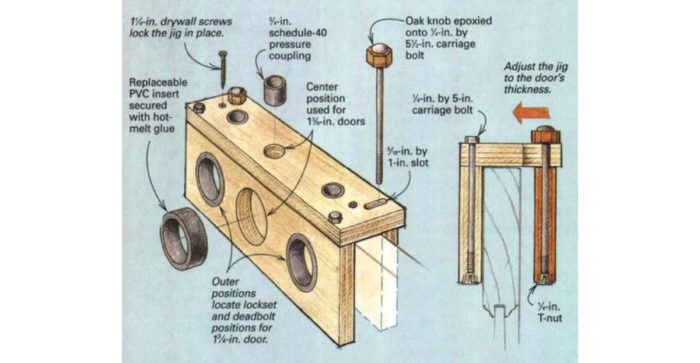A Door Hanger’s Jigs
A door specialist reveals a few shop-made accessories that make the job faster and easier.

I’ve been a finish carpenter for a number of years now, and by a rough estimate I have hung about 3,600 doors. Door hanging involves many repetitive operations, such as mortising hinges and drilling locksets, so it makes sense to use jigs. On a typical job, I might have 20 or 30 doors to hang; using jigs, I can cut my installation time in half.
Factory-made jigs, such as those for cutting hinge mortises or boring locksets, are tempting, but they are expensive. So when I need a special jig or can’t afford the commercial model, I make it myself. Although it takes extra time to build, a jig usually saves me time in the long run, and the process keeps me in tune with my work.
Lockset Jig Reduces Layout Time
The jig shown in the drawing is my plywood version of commercially-available lockset jigs that are used to drill holes through the face and edge of a door. Unlike the steel models that template only one lockset at a time, my jig lets me drill both lockset and deadbolt at the same time from either side of the jig. The width of my jig (4 in.) is also substantially less than the commercial jigs and won’t interfere with any door’s raised cope and sticking. I cut removable inserts from ¾-in. thick PVC sheet (available from most plastics-supply outlets); these inserts prevent excess wear on the plywood. I can adjust the jig for door thicknesses that vary from 1 1/4 in. to 1 7/8 in., and I set the bore locations for the most common backset, 2 3/8 in. Once the jig is in place (typically centered 44 1/16 in. from the top of a 6-ft. 8-in. door), I lock it down to the door with 1 1/4-in. drywall screws and bore the holes for the lockset with the appropriate Forstner bit.
Door-Edge Mortising Jig Has Multiple Uses
I typically use the door-edge jig when I have to repair the edge of a door. If someone else has botched the job of installing a strike or if the position of the strike needs to be changed, I rout a mortise into the door edge and fill it with a tight-fitting dutchman, or patch. After the glue dries, I can drill a new hole.
This setup is made to be used with a plunge router fitted with a straight mortising bit. The jig centers the router on a self-clamping platform that slides along the door’s edge, providing a stable base for the router. The jig ensures a straight, even mortise while keeping the router bit from wandering off the edge of the door. The jig is made up of two halves connected by 3/8-in. steel rods and, like the previous jig, can be adjusted to varying door widths by loosening the oak-handle carriage bolts. The steel rods fit through the edge-guide holes in the router’s base, fixing the router’s position to the base.
Dual-Axis Jig And Router Cut A Flat And Square Mortise
I use the jig shown below when I want to relocate the lockset on a door and need to patch the old location with a dutchman. The beauty of this jig is that it enables me to cut a perfectly flat mortise over an area that’s larger than the router’s base. In addition, the adjustable stops ensure that the mortise’s dimensions will be precise. The resulting mortise has a flat bottom and square sides, and it is a cinch to fill.
The router is clamped onto a carriage that slides laterally on a pair of 3⁄4-in. rods and moves forward and back on drawer slides. Once the jig is screwed and clamped to the door, I can set the stops to limit the cut across the width and length of the door’s stile. I set up the plunge router with a 1-in. straight bit and clamp it into the jig. Typically, I begin by setting the cutting depth to approximately 1⁄8 in. and increase the depth by the same increment at each pass.
I kept the cost of the jig to a minimum by using scrap and spare parts where possible; my only outlay was for the 3⁄4-in. rods and the stop collars, which I bought at the local hardware store, and the toggle clamps, which are available from most tool catalogs.
|
Dual-axis jig makes nearly invisible door repairs. For door repairs, the author cuts a mortise across the width of a stile, a technique that eliminates one visible joint. |
Recycled hinge pins serve as a stop. The travel of the router carriage can be limited by inserting the pin into any one of the indexed holes. |
 |
 |
Door Bench Reduces The Backache Of Prepping Doors
Door benches have been a fixture in the door-hanger’s trade for decades, and they must have been invented by some anonymous carpenter who was sick and tired of bending over a door that wobbled around while he tried to cut the hinge mortises. Typically, the benches combine a portable work surface with handy tool storage, they are easy to carry, and they allow a carpenter to stand comfortably while the carpenter readies a door for hanging.
I’ve used knock-together door benches for years but was always too busy to make anything better. When the recession hit our neck of the woods in the early ’90s, I used my extra time to build a sturdy bench (drawing below) that was good looking and easy to set up. The new bench featured storage compartments for all my door-hanging tools, sliding drawers, padded rests, fold-down legs (photo bottom left) and a wheel so that I could pack up the bench and roll it into the back of my truck or the trunk of a car. Best of all, it has adjustable door bucks on the legs that allow me to position doors of the most common widths to a consistent working level.
The main interior box is made of Baltic-birch cabinet-grade plywood, and the frame and legs are 5/4 red oak. Each pair of oak legs is connected by a horizontal stretcher dovetailed into the top; this assembly pivots on the upper portion of the frame and can be locked in standing or folding position with carriage bolts and T-nuts. When the legs are locked into the standing position, the horizontal stretchers also form an attachment point for removable padded rests that won’t scratch the door’s finish. When not in use, these rests are tucked into hardboard gussets.
|
Door bucks save the carpenter’s back. Because door bucks are adjustable, the author can position doors to a consistent working height. |
 |
For more photos, drawings, and details, click the View PDF button below:





